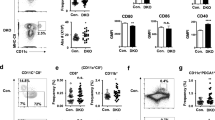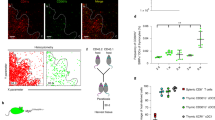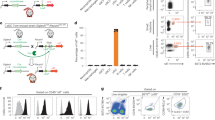Abstract
Three distinct promoters control the master regulator of major histocompatibility complex (MHC) class II expression, class II transactivator (CIITA), in a cell type-specific manner. Promoter I (pI) CIITA, expressed primarily by dendritic cells (DCs) and macrophages, expresses a unique isoform that contains a caspase-recruitment domain (CARD). The activity and function of this isoform are not understood, but are believed to enhance the function of CIITA in antigen-presenting cells. To determine whether isoform I of CIITA has specific functions, CIITA mutant mice were created in which isoform I was replaced with isoform III sequences. Mice in which pI and the CARD-encoding exon were deleted were also created. No defect in the formation of CD4 T cells, the ability to respond to a model antigen or bacterial or viral challenge was observed in mice lacking CIITA isoform I. Although CIITA and MHC-II expression was decreased in splenic DCs, pI knockout animals expressed CIITA from downstream promoters, suggesting that control of pI activity is mediated by unknown distal elements that could act at pIII, the B-cell promoter. Thus, no critical function is linked to the CARD domain of CIITA isoform I with respect to basic immune system development, function and challenge.
This is a preview of subscription content, access via your institution
Access options
Subscribe to this journal
Receive 6 digital issues and online access to articles
$119.00 per year
only $19.83 per issue
Buy this article
- Purchase on Springer Link
- Instant access to full article PDF
Prices may be subject to local taxes which are calculated during checkout









Similar content being viewed by others
References
Benacerraf B . Role of MHC gene products in immune regulation. Science 1981; 212: 1229–1238.
Ting JP, Trowsdale J . Genetic control of MHC class II expression. Cell 2002; 109 (Suppl): S21–S33.
Reith W, LeibundGut-Landmann S, Waldburger JM . Regulation of MHC class II gene expression by the class II transactivator. Nat Rev 2005; 5: 793–806.
Kanazawa S, Ota S, Sekine C, Tada T, Otsuka T, Okamoto T et al. Aberrant MHC class II expression in mouse joints leads to arthritis with extraarticular manifestations similar to rheumatoid arthritis. Proc Natl Acad Sci USA 2006; 103: 14465–14470.
Krawczyk M, Reith W . Regulation of MHC class II expression, a unique regulatory system identified by the study of a primary immunodeficiency disease. Tissue Antigens 2006; 67: 183–197.
Reith W, Steimle V, Mach B . Molecular defects in the bare lymphocyte syndrome and regulation of MHC class II genes. Immunol Today 1995; 16: 539–546.
Steimle V, Otten LA, Zufferey M, Mach B . Complementation cloning of an MHC class II transactivator mutated in hereditary MHC class II deficiency (or bare lymphocyte syndrome). Cell 1993; 75: 135–146.
Choi NM, Majumder P, Boss JM . Regulation of major histocompatibility complex class II genes. Curr Opin Immunol 2011; 23: 81–87.
Muhlethaler-Mottet A, Otten LA, Steimle V, Mach B . Expression of MHC class II molecules in different cellular and functional compartments is controlled by differential usage of multiple promoters of the transactivator CIITA. EMBO J 1997; 16: 2851–2860.
Pai RK, Askew D, Boom WH, Harding CV . Regulation of class II MHC expression in APCs: roles of types III I, and IV II class transactivator. J Immunol 2002; 169: 1326–1333.
Waldburger JM, Suter T, Fontana A, Acha-Orbea H, Reith W . Selective abrogation of major histocompatibility complex class II expression on extrahematopoietic cells in mice lacking promoter IV of the class II transactivator gene. J Exp Med 2001; 194: 393–406.
Nickerson K, Sisk TJ, Inohara N, Yee CS, Kennell J, Cho MC et al. Dendritic cell-specific MHC class II transactivator contains a caspase recruitment domain that confers potent transactivation activity. J Biol Chem 2001; 276: 19089–19093.
Hofmann K, Bucher P, Tschopp J . The CARD domain: a new apoptotic signalling motif. Trends Biochem Sci 1997; 22: 155–156.
Inohara, Chamaillard, McDonald C, Nunez G . NOD-LRR proteins: role in host-microbial interactions and inflammatory disease. Annu Rev Biochem 2005; 74: 355–383.
Ye Z, Ting JP . NLR, the nucleotide-binding domain leucine-rich repeat containing gene family. Curr Opin Immunol 2008; 20: 3–9.
Ting JP, Lovering RC, Alnemri ES, Bertin J, Boss JM, Davis BK et al. The NLR gene family: a standard nomenclature. Immunity 2008; 28: 285–287.
Harton JA, Linhoff MW, Zhang J, Ting JP . Cutting edge: CATERPILLER: a large family of mammalian genes containing CARD, pyrin, nucleotide-binding, and leucine-rich repeat domains. J Immunol 2002; 169: 4088–4093.
Inohara N, Nunez G . NODs: intracellular proteins involved in inflammation and apoptosis. Nat Rev 2003; 3: 371–382.
Elinav E, Strowig T, Henao-Mejia J, Flavell RA . Regulation of the antimicrobial response by NLR proteins. Immunity 2011; 34: 665–679.
LeibundGut-Landmann S, Waldburger JM, Reis e Sousa C, Acha-Orbea H, Reith W . MHC class II expression is differentially regulated in plasmacytoid and conventional dendritic cells. Nat Immunol 2004; 5: 899–908.
Waldburger JM, Rossi S, Hollander GA, Rodewald HR, Reith W, Acha-Orbea H . Promoter IV of the class II transactivator gene is essential for positive selection of CD4+ T cells. Blood 2003; 101: 3550–3559.
Markel P, Shu P, Ebeling C, Carlson GA, Nagle DL, Smutko JS et al. Theoretical and empirical issues for marker-assisted breeding of congenic mouse strains. Nat Genet 1997; 17: 280–284.
Shortman K, Liu YJ . Mouse and human dendritic cell subtypes. Nat Rev 2002; 2: 151–161.
Krawczyk M, Seguin-Estevez Q, Leimgruber E, Sperisen P, Schmid C, Bucher P et al. Identification of CIITA regulated genetic module dedicated for antigen presentation. PLoS Genet 2008; 4: e1000058.
Nagarajan UM, Bushey A, Boss JM . Modulation of gene expression by the MHC class II transactivator. J Immunol 2002; 169: 5078–5088.
Wong AW, Brickey WJ, Taxman DJ, van Deventer HW, Reed W, Gao JX et al. CIITA-regulated plexin-A1 affects T-cell-dendritic cell interactions. Nat Immunol 2003; 4: 891–898.
Yee CS, Yao Y, Li P, Klemsz MJ, Blum JS, Chang CH . Cathepsin E: a novel target for regulation by class II transactivator. J Immunol 2004; 172: 5528–5534.
Buttice G, Miller J, Wang L, Smith BD . Interferon-gamma induces major histocompatibility class II transactivator (CIITA), which mediates collagen repression and major histocompatibility class II activation by human aortic smooth muscle cells. Circ Res 2006; 98: 472–479.
Hornell TM, Burster T, Jahnsen FL, Pashine A, Ochoa MT, Harding JJ et al. Human dendritic cell expression of HLA-DO is subset specific and regulated by maturation. J Immunol 2006; 176: 3536–3547.
Fallas JL, Yi W, Draghi NA, O′Rourke HM, Denzin LK . Expression patterns of H2-O in mouse B cells and dendritic cells correlate with cell function. J Immunol 2007; 178: 1488–1497.
Klein L, Hinterberger M, Wirnsberger G, Kyewski B . Antigen presentation in the thymus for positive selection and central tolerance induction. Nat Rev 2009; 9: 833–844.
Ohnmacht C, Pullner A, King SB, Drexler I, Meier S, Brocker T et al. Constitutive ablation of dendritic cells breaks self-tolerance of CD4T cells and results in spontaneous fatal autoimmunity. J Exp Med 2009; 206: 549–559.
Hinterberger M, Aichinger M, da Costa OP, Voehringer D, Hoffmann R, Klein L . Autonomous role of medullary thymic epithelial cells in central CD4(+) T cell tolerance. Nature Immunol 2010; 11: 512–519.
van Meerwijk JP, Marguerat S, Lees RK, Germain RN, Fowlkes BJ, MacDonald HR . Quantitative impact of thymic clonal deletion on the T cell repertoire. J Exp Med 1997; 185: 377–383.
Schnappauf F, Hake SB, Camacho Carvajal MM, Bontron S, Lisowska-Grospierre B, Steimle V . N-terminal destruction signals lead to rapid degradation of the major histocompatibility complex class II transactivator CIITA. Eur J Immunol 2003; 33: 2337–2347.
Oxenius A, Bachmann MF, Ashton-Rickardt PG, Tonegawa S, Zinkernagel RM, Hengartner H . Presentation of endogenous viral proteins in association with major histocompatibility complex class II: on the role of intracellular compartmentalization, invariant chain and the TAP transporter system. Eur J Immunol 1995; 25: 3402–3411.
Suter T, Malipiero U, Otten L, Ludewig B, Muelethaler-Mottet A, Mach B et al. Dendritic cells and differential usage of the MHC class II transactivator promoters in the central nervous system in experimental autoimmune encephalitis. Eur J Immunol 2000; 30: 794–802.
Freeman MM, Ziegler HK . Simultaneous Th1-type cytokine expression is a signature of peritoneal CD4+ lymphocytes responding to infection with Listeria monocytogenes. J Immunol 2005; 175: 394–403.
Wherry EJ, Blattman JN, Murali-Krishna K, van der Most R, Ahmed R . Viral persistence alters CD8 T-cell immunodominance and tissue distribution and results in distinct stages of functional impairment. J Virol 2003; 77: 4911–4927.
Karlsson L, Surh CD, Sprent J, Peterson PA . A novel class II MHC molecule with unusual tissue distribution. Nature 1991; 351: 485–488.
Taxman DJ, Cressman DE, Ting JP . Identification of class II transcriptional activator-induced genes by representational difference analysis: discoordinate regulation of the DN alpha/DO beta heterodimer. J Immunol 2000; 165: 1410–1416.
Chang CH, Guerder S, Hong SC, van Ewijk W, Flavell RA . Mice lacking the MHC class II transactivator (CIITA) show tissue-specific impairment of MHC class II expression. Immunity 1996; 4: 167–178.
Nagarajan UM, Lochamy J, Chen X, Beresford GW, Nilsen R, Jensen PE et al. Class II transactivator is required for maximal expression of HLA-DOB in B cells. J Immunol 2002; 168: 1780–1786.
Smith MA, Wright G, Wu J, Tailor P, Ozato K, Chen X et al. Positive regulatory domain I (PRDM1) and IRF8/PU.1 counter-regulate MHC class II transactivator (CIITA) expression during dendritic cell maturation. J Biol Chem 2011; 286: 7893–7904.
Choi YE, Yu HN, Yoon CH, Bae YS . Tumor-mediated down-regulation of MHC class II in DC development is attributable to the epigenetic control of the CIITA type I promoter. Eur J Immunol 2009; 39: 858–868.
Ghosh N, Piskurich JF, Wright G, Hassani K, Ting JP, Wright KL . A novel element and a TEF-2-like element activate the major histocompatibility complex class II transactivator in B-lymphocytes. J Biol Chem 1999; 274: 32342–32350.
van der Stoep N, Quinten E, van den Elsen PJ . Transcriptional regulation of the MHC class II trans-activator (CIITA) promoter III: identification of a novel regulatory region in the 5′-untranslated region and an important role for cAMP-responsive element binding protein 1 and activating transcription factor-1 in CIITA-promoter III transcriptional activation in B lymphocytes. J Immunol 2002; 169: 5061–5071.
van der Stoep N, Quinten E, Rezende MM, van den Elsen PJ . E47, IRF-4, and PU. 1 synergize to induce B-cell-specific activation of the class II transactivator promoter III (CIITA-PIII). Blood 2004; 104: 2849.
Yoon H, Boss JM . PU.1 binds to a distal regulatory element that is necessary for B cell-specific expression of CIITA. J Immunol 2010; 184: 5018–5028.
Morris AC, Beresford GW, Mooney MR, Boss JM . Kinetics of a gamma interferon response: expression and assembly of CIITA promoter IV and inhibition by methylation. Mol Cell Biol 2002; 22: 4781–4791.
Muhlethaler-Mottet A, Di Berardino W, Otten LA, Mach B . Activation of the MHC class II transactivator CIITA by interferon-gamma requires cooperative interaction between Stat1 and USF-1. Immunity 1998; 8: 157–166.
Piskurich JF, Linhoff MW, Wang Y, Ting JP . Two distinct gamma interferon-inducible promoters of the major histocompatibility complex class II transactivator gene are differentially regulated by STAT1, interferon regulatory factor 1, and transforming growth factor beta. Mol Cell Biol 1999; 19: 431–440.
Morris AC, Spangler WE, Boss JM . Methylation of class II trans-activator promoter IV: a novel mechanism of MHC class II gene control. J Immunol 2000; 164: 4143–4149.
van Eggermond MC, Boom DR, Klous P, Schooten E, Marquez VE, Wierda RJ et al. Epigenetic regulation of CIITA expression in human T-cells. Biochem Pharmacol 2011; 82: 1430–1437.
Ni Z, Abou El Hassan M, Xu Z, Yu T, Bremner R . The chromatin-remodeling enzyme BRG1 coordinates CIITA induction through many interdependent distal enhancers. Nat Immunol 2008; 9: 785–793.
Estill SJ, Garcia JA . A marker assisted selection protocol (MASP) to generate C57BL/6J or 129S6/SvEvTac speed congenic or consomic strains. Genesis 2000; 28: 164–166.
Blake JA, Bult CJ, Kadin JA, Richardson JE, Eppig JT . The Mouse Genome Database (MGD): premier model organism resource for mammalian genomics and genetics. Nucleic Acids Res 2011; 39 (Database issue): D842–D848.
Inaba K, Swiggard WJ, Steinman RM, Romani N, Schuler G, Brinster C . Isolation of dendritic cells. Curr Protoc Immunol 2009; 86: 3.7.1–3.7.19.
Zhang B, Zhang Y, Niu L, Vella AT, Mittler RS . Dendritic cells and Stat3 are essential for CD137-induced CD8T cell activation-induced cell death. J Immunol 2010; 184: 4770–4778.
Ford ML, Evavold BD . Regulation of polyclonal T cell responses by an MHC anchor-substituted variant of myelin oligodendrocyte glycoprotein 35-55. J Immunol 2003; 171: 1247–1254.
Sabatino Jr JJ, Shires J, Altman JD, Ford ML, Evavold BD . Loss of IFN-gamma enables the expansion of autoreactive CD4+ T cells to induce experimental autoimmune encephalomyelitis by a nonencephalitogenic myelin variant antigen. J Immunol 2008; 180: 4451–4457.
Mendel I, Kerlero de Rosbo N, Ben-Nun A . A myelin oligodendrocyte glycoprotein peptide induces typical chronic experimental autoimmune encephalomyelitis in H-2b mice: fine specificity and T cell receptor V beta expression of encephalitogenic T cells. Eur J Immunol 1995; 25: 1951–1959.
Homann D, Teyton L, Oldstone MB . Differential regulation of antiviral T-cell immunity results in stable CD8+ but declining CD4+ T-cell memory. Nat Med 2001; 7: 913–919.
Wherry EJ, Ha SJ, Kaech SM, Haining WN, Sarkar S, Kalia V et al. Molecular signature of CD8+ T cell exhaustion during chronic viral infection. Immunity 2007; 27: 670–684.
Fuller MJ, Hildeman DA, Sabbaj S, Gaddis DE, Tebo AE, Shang L et al. Cutting edge: emergence of CD127high functionally competent memory T cells is compromised by high viral loads and inadequate T cell help. J Immunol 2005; 174: 5926–5930.
Elsaesser H, Sauer K, Brooks DG . IL-21 is required to control chronic viral infection. Science 2009; 324: 1569–1572.
Skountzou I, Quan FS, Jacob J, Compans RW, Kang SM . Transcutaneous immunization with inactivated influenza virus induces protective immune responses. Vaccine 2006; 24: 6110–6119.
Koutsonanos DG, del Pilar Martin M, Zarnitsyn VG, Sullivan SP, Compans RW, Prausnitz MR et al. Transdermal influenza immunization with vaccine-coated microneedle arrays. PLoS One 2009; 4: e4773.
WHO/CDS/CSR/NCS. WHO Manual on Animal Influenza Diagnostics and Surveillance. In: Response DoCDSa (ed). World Heath Organization, Geneva, Switzerland, 2002.
Schmittgen TD, Livak KJ . Analyzing real-time PCR data by the comparative C(T) method. Nat Protoc 2008; 3: 1101–1108.
Acknowledgements
We thank Dr Joseph Sabatino for help with some of the experiments presented. We also thank the Emory University School of Medicine Core Facility for Flow Cytometry and the NIH tetramer core. This study was supported by the National Institutes of Health grants RO1AI43000 and R56AI34000 (to JMB), PO1 AI080192-01 (to JMB and RA), HHSN266 200700006CMD8 (to IS) and the American Cancer Society postdoctoral fellowship PF-09-134-01-MPC (to BY).
Author information
Authors and Affiliations
Corresponding author
Ethics declarations
Competing interests
The authors declare no conflict of interest.
Additional information
Supplementary Information accompanies the paper on Genes and Immunity website
Rights and permissions
About this article
Cite this article
Zinzow-Kramer, W., Long, A., Youngblood, B. et al. CIITA promoter I CARD-deficient mice express functional MHC class II genes in myeloid and lymphoid compartments. Genes Immun 13, 299–310 (2012). https://doi.org/10.1038/gene.2011.86
Received:
Revised:
Accepted:
Published:
Issue Date:
DOI: https://doi.org/10.1038/gene.2011.86
Keywords
This article is cited by
-
A caspase-2-RFXANK interaction and its implication for MHC class II expression
Cell Death & Disease (2018)



